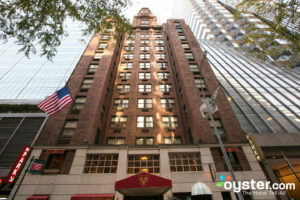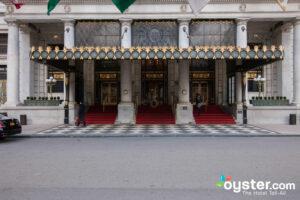Literary hotels in New York: Stay where your favorite authors lived and wrote
Most of our country’s greatest literary minds have lived or stayed in New York City at one point or another. And as wordsmiths dedicated to lives of pen and paper, they inevitably wrote during their time in the Big Apple. We checked out the hotels where they met, stayed, and wrote, from seedy rest stops with cheap rent, to meeting places for witty exchange amongst fellow authors, to sites of lavish celebrations of one’s literary success. So gather up your book club (or just your nose-in-novel honey) and head to NYC to visit the hotel haunts where your favorite authors were inspired–you just may be inspired too.

Hotel Elysee by Library Hotel Collection
Midtown East, New York City, New York, United States
Many recognizable names–Joe DiMaggio, Marlon Brando, Ava Gardner–have called Hotel Elysee home, but possibly the most notable resident is playwright Tennessee Williams, who lived in the hotel for fifteen years until his death in 1983. Williams wrote all of his later works in his suite (named the Sunset Suite in his honor) and guests were known to complain that they could hear his typing late into the night.
Read: A House Not Meant to Stand, by Tennessee Williams Tennessee Williams’ final play, A House Not Meant to Stand, is a dark comedy set in rural Mississippi (where Williams grew up). He wrote it in his suite at Hotel Elysee and it was produced in the final years of his life at the Goodman Theatre in Chicago. However, it wasn’t published until 2008.

Washington Square Hotel
West Village, New York City, New York, United States
On his first tour of the United States, Welsh poet and writer Dylan Thomas lived in the Washington Square Hotel (then the Hotel Earle) after being kicked out of his previous hotel for his loud, late-night partying and outlandish room service requests. Thomas liked his new location because of the easy-going staff and its proximity to his favorite Greenwich Village bars.
Read: Under Milk Wood, by Dylan Thomas Thomas’ most famous piece, Under Milk Wood, is a play he wrote for the radio in 1954 that was later adapted for the stage and then screen (in the same-titled 1972 film starring Elizabeth Taylor, Richard Burton, and Peter O’Toole). Set in a fictitious Welsh village called Llareggub (read it backwards), it exposes the innermost thoughts of its cast of curious characters through the all-knowing “eyes” of the blind Captain Cat.

The Plaza
New York City, New York, United States
The century-old Plaza is a New York City landmark that has been the site of extravagant weddings (Michael Douglas and Catherine Zeta-Jones), Oscar-winning movies (Almost Famous), and A-list parties (Truman Capote’s Black and White Ball). After the success of In Cold Blood, Capote threw a lavish party, called the Black and White Ball, at The Plaza in honor of his book and The Washington Post publisher Katharine Graham. Invitations were highly sought after and only the most elite of the “in”-crowd were on the guest list.
Read: In Cold Blood, by Truman Capote Truman Capote completed In Cold Blood in 1966, after six long years of research and writing. The highly-acclaimed non-fiction novel tells the gory story of the 1959 murders of a wealthy Kansas farmer and his family. It examines the psychological relationship between the murderers as well as the lives of the victims and the impact their deaths had on the community.

The Algonquin Hotel Times Square, Autograph Collection
Midtown West, New York City, New York, United States
The Algonquin Hotel was the site of the famous Round Table meetings in the 1920s. A group of writers, critics, and actors, the Round Table — including names like Robert E. Sherwood, Dorothy Parker, George F. Kaufman, and Edna Ferber — met for lunch daily to discuss everything from literature to politics. They collaborated on a revue titled No Sirree! to jump-start the Hollywood career of fellow Round Tabler Robert Benchley. This group is also responsible for founding The New Yorker, which is free for hotel guests. The Algonquin has hosted many other notable literary minds as well — one of the first hotels to accept single female guests, the Algonquin has hosted the likes of Gertrude Stein and Maya Angelou. William Faulkner wrote his acceptance speech for the 1949 Nobel Prize in the hotel’s lobby.
Read: As I Lay Dying, by William Faulkner William Faulkner wrote As I Lay Dying, his most famous novel — ranked among the best novels of twentieth-century literature — in just six weeks. Written in a stream of consciousness, As I Lay Dying tells the story of the death of Addie Bundren and her family’s struggle to honor her dying request.

